Eurasian Jay
Garrulus glandarius
The Eurasian jay has the ability to mimic other sounds
Advertisement
Eurasian Jay Scientific Classification
- Kingdom
- Animalia
- Phylum
- Chordata
- Class
- Aves
- Order
- Passeriformes
- Family
- Corvidae
- Genus
- Garrulus
- Scientific Name
- Garrulus glandarius
Read our Complete Guide to Classification of Animals.
Eurasian Jay Conservation Status
Eurasian Jay Facts
- Prey
- Fruits, grains, nuts, snails, slugs, worms, insects, and birds
- Fun Fact
- The Eurasian jay has the ability to mimic other sounds
- Estimated Population Size
- 30-65 million mature individuals
- Biggest Threat
- Habitat loss
- Most Distinctive Feature
- The bright blue wing feathers
- Other Name(s)
- Common jay
- Wingspan
- 52-58m (20-23in)
- Incubation Period
- 18 days
- Habitat
- Mixed forests and grasslands
- Predators
- Cats, martens, owls, crows, eagles, and others
- Diet
- Omnivore
- Type
- Bird
- Common Name
- Eurasian jay
- Number Of Species
- 1
- Location
- Eurasia and North Africa
- Nesting Location
- Trees and bushes
- Age of Molting
- 20-23 days
View all of the Eurasian Jay images!
The Eurasian jay is one of the most common songbird species on the entire Eurasian supercontinent.
These graceful and highly intelligent birds can be seen flying around treetops and bushes. One of their most unique adaptations is the ability to bury acorns in the ground for later use. They play an important ecological role by dispersing seeds throughout the environment. If they never return to the acorn, then it may later grow into a tree. This helps to regenerate old oak forests.
3 Eurasian Jay Amazing Facts
- In order to keep its feathers free of parasites, the Eurasian jay will cover itself in ants, which release formic acid to kill any unwanted stragglers. This behavior is known as anting.
- A single jay can bury between 4,500 and 11,000 acorns a year and remember their location up to 10 months later.
- The jay’s wings have the ability to reflect ultraviolet light that humans cannot see. This appears to play an important role in the bird’s mating rituals.
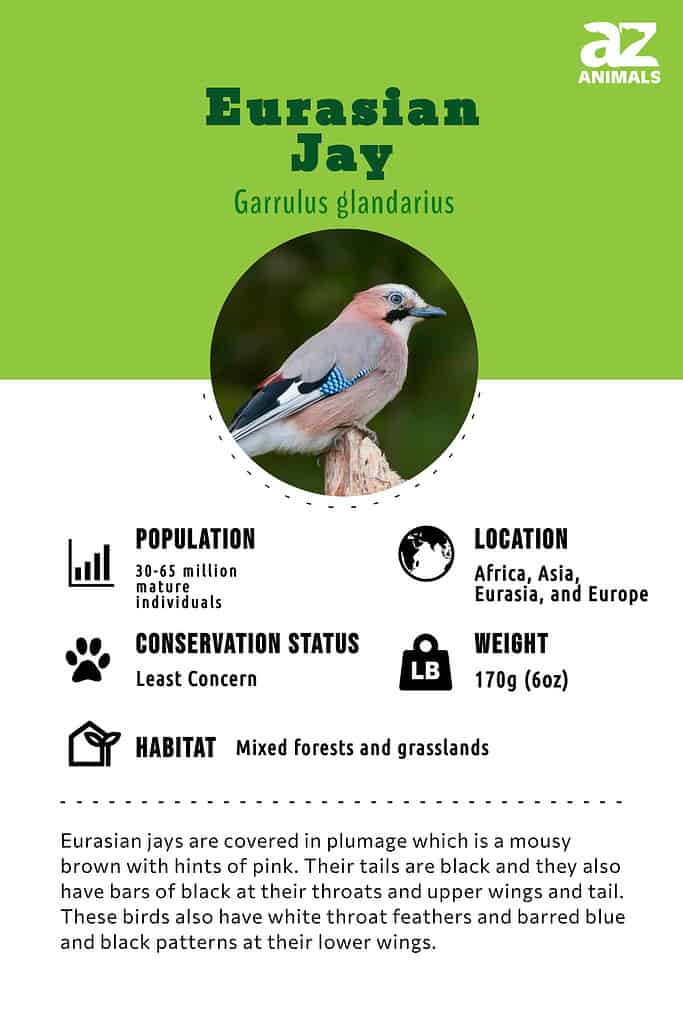
Where to Find the Eurasian Jay
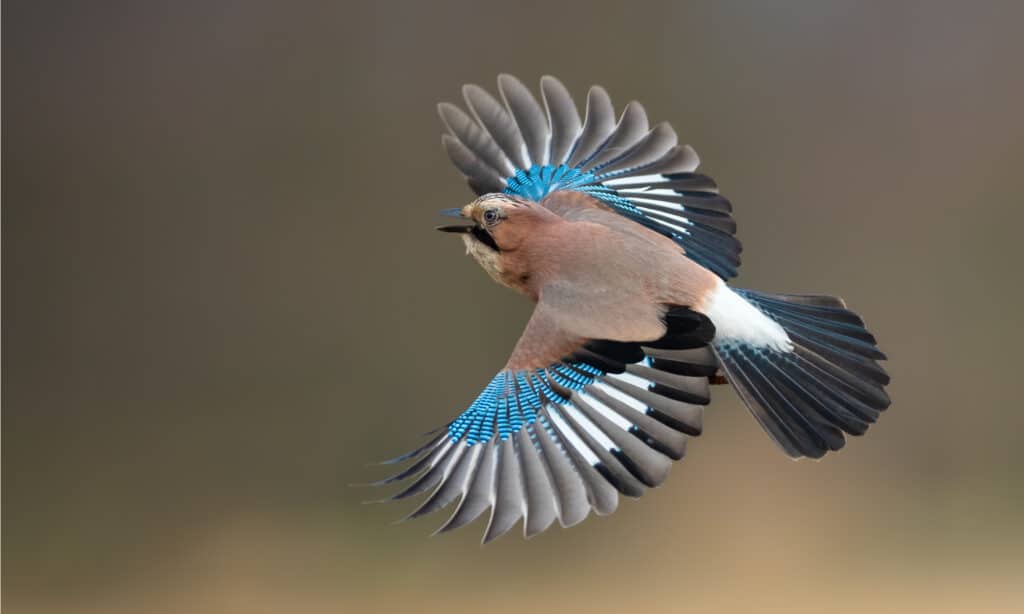
Eurasian jays can be found in Asia, Europe, and North
Africa
©Rafal Szozda/Shutterstock.com
The Eurasian jay can be found in locations with plenty of dense foliage and tree cover throughout temperate Europe, Asia, and northern Africa. They exhibit very little migration between different areas in their range, instead preferring to stay in the same place with enough food. Deciduous trees and oak forests give them plenty of foraging opportunities, but coniferous trees often provide the best nesting sites. English oaks, cork oaks, sessile oaks, and Portuguese oaks are among their favorite trees.
Nests
The Eurasian jay constructs a small cup-shaped nest made from sticks, roots, hairs, and feathers in a bush or tree.
Scientific Name
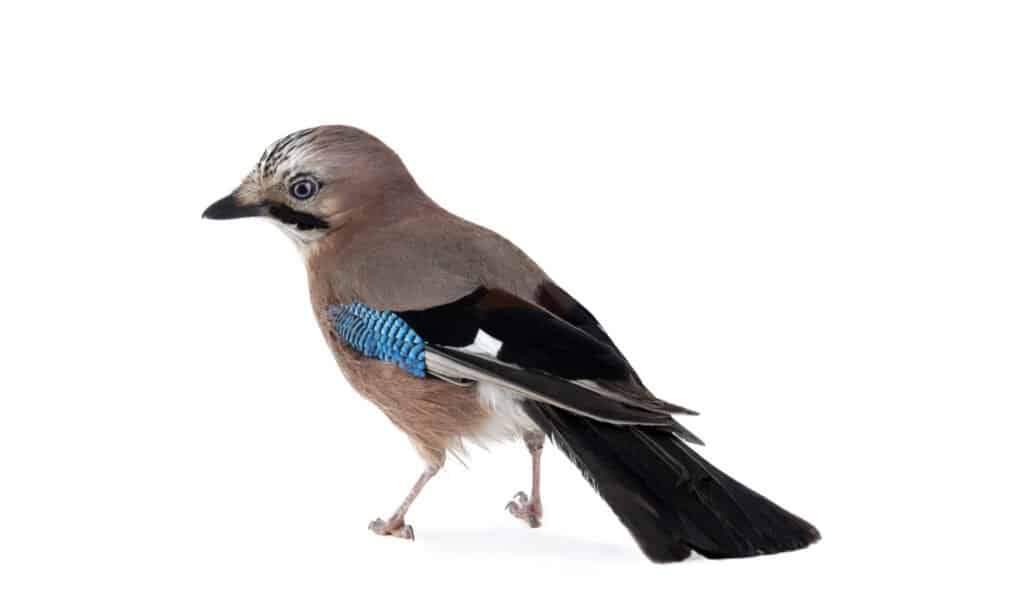
Eurasian jays are close relatives of black-headed and Lidth jays
©photomaster/Shutterstock.com
The scientific name of the Eurasian jay is Garrulus glandarius. Garrulus is derived from a Latin word that means chatty, noisy, or babbling. Glandarius derives from a Latin word that means acorn or nut; this refers to its habit of storing and eating acorns. The Eurasian jay is closely related to the black-headed jay of central Asia and Lidth’s jay of Japan. There are several recognized subspecies, all of which differ slightly in their plumage colors and ranges.
Evolution
Eurasian jays belong to the genus Garrulus and are closely related to black-headed and Lidth jays, as a result. Because they also belong to the wider Corvidae family, they are also the cousins of crows, jackdaws, and ravens, unlikely though it may seem.
Other cousins in this large family comprising 135 species include choughs, magpies, nutcrackers, and treepies. The story of this family dates back to the Miocene which itself extends from 5.33 – 23.03 million years ago. The earliest genera date from the Middle Miocene and include the Miocorvus which is believed to be possibly the ancestor of present-day crows, jays, and magpies.
This genus is believed to have emerged in the southwest of France. The Miopica found in Ukraine, also belongs to the same classification.
Size, Appearance, and Behavior
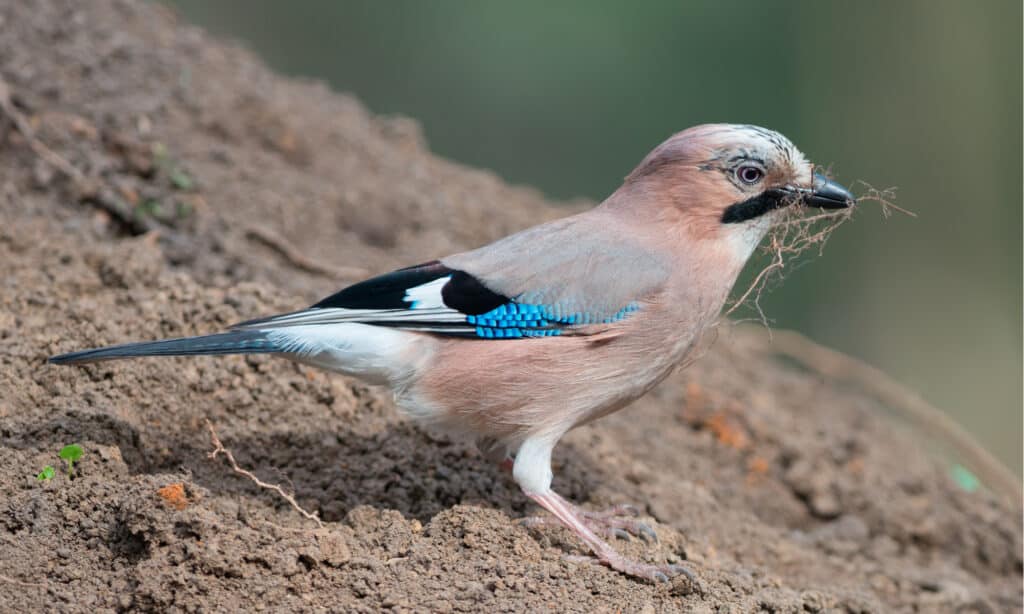
The Eurasian jay is capable of mimicking sounds from other birds including those made by birds of prey
©Ryzhkov Sergey/Shutterstock.com
The Eurasian jay is relatively small for a member of the Corvid family. It measures about 13 inches tall and almost 2 feet long with its wings fully extended. The body is characterized by reddish-brown feathers with bright blue spots and black speckles along the wings. White bands are also visible during flight. The jay has a large crest on its head with white and black speckles. It raises this crest to communicate with other birds. Females tend to be larger, but otherwise, their appearance is similar to the males.
In addition to its crest, the Eurasian jay utilizes a number of different positions, movements, and calls to communicate. It will extend the wings outward when expressing submissive behavior. It will make a series of frantic movements and screech when it feels alarmed or threatened. There are also vocalizations and displays for anger, playfulness, and desire. Like other types of Corvids, the Eurasian jay is an expert at mimicry. It will compose songs from sounds it has heard in the environment, including lawnmowers and other animals. The mimicry may serve the purpose of expressing emotions it felt at the time of hearing the sound. This enables them to deploy sounds with the same context in which it was heard. For instance, when threatened, it may mimic harsher sounds.
Eurasian jays spend at least part of the year gathered together in large groups with fluid hierarchies. Males are usually dominant over females, but this is not always the case. Females may sometimes be the dominant partner like when the male is molting. Dominance disputes may be sometimes settled with fights. These birds remain in the same place for most of the year, but they might complete a very short migration in response to food shortages.
Diet
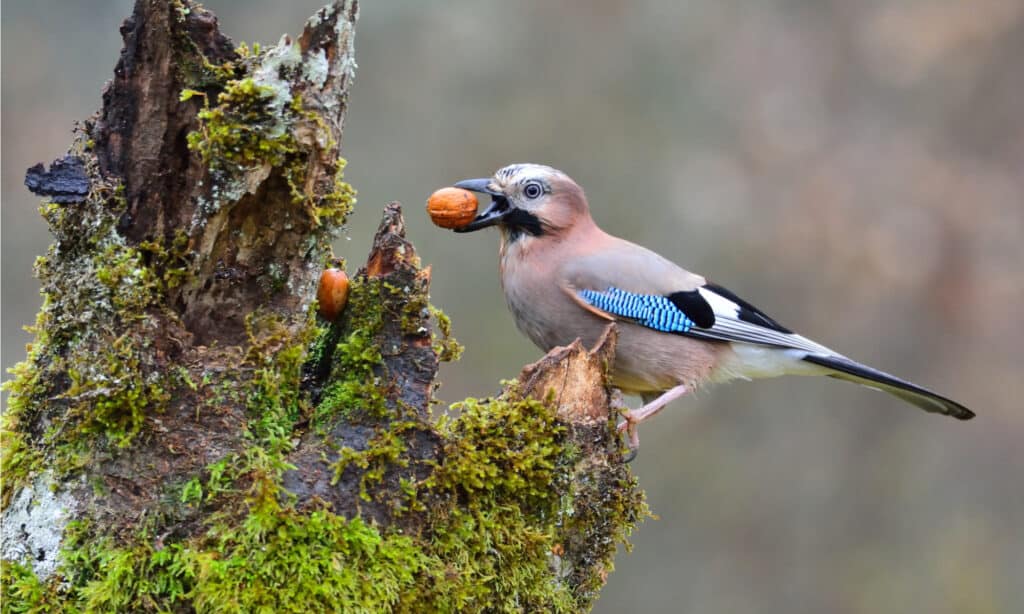
Eurasian jays have a diet which consists of acorns, berries, insects, and invertebrates
©StockPhotoAstur/Shutterstock.com
The Eurasian jay is best described as an opportunistic omnivore. It will consume almost anything it can find. These birds spend most of their day flying around and foraging in trees, but they do sometimes forage along the ground as well.
What does the Eurasian jay eat?
Eurasian jays will consume fruits, grains, nuts, snails, slugs, worms, and insects, but by far its favorite food is the acorn. Jays have an instinctive ability to crack open the shell by using their beaks as a lever. They collect fresh high-quality acorns in the fall and bury them for use throughout the year. They will carry acorns in the bill and also store them in their crop (an organ located near the esophagus). Besides acorns, other potential sources of food include small birds, eggs, and carrion.
Predators, Threats, and Conservation Status
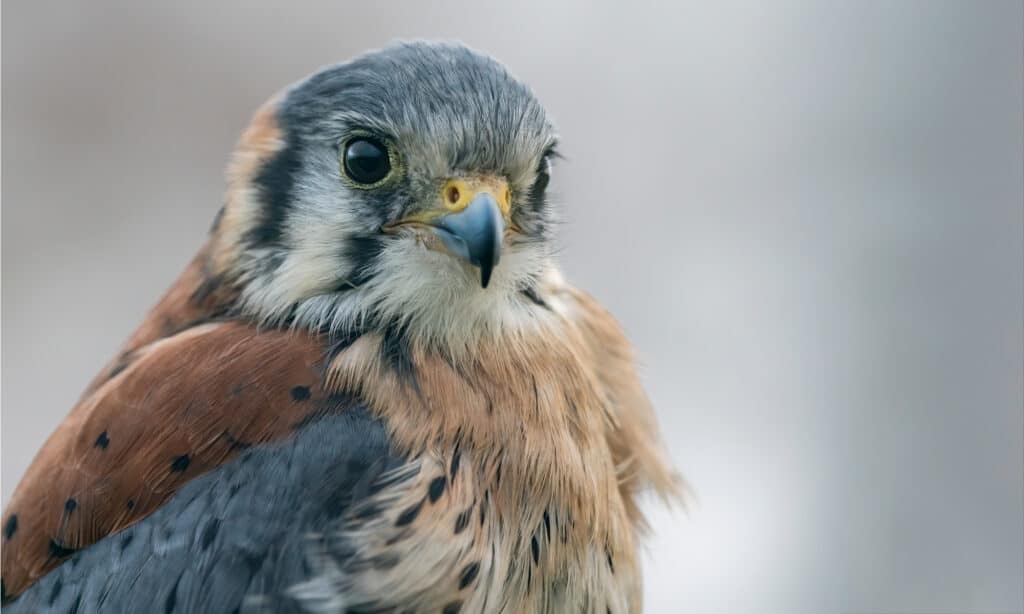
The kestrel is known to be one of the Eurasian Jay’s predators
©Albert Beukhof/Shutterstock.com
According to the IUCN Red List, the Eurasian jay is a species of least concern. This means it is not currently threatened in any significant manner. But because they rely so much on tree and brush cover, they can be affected by habitat loss.
What eats the Eurasian jay?
The Eurasian jay is preyed upon by numerous predators, including martens, cats, eagles, owls, crows, kestrels, and other birds. If threatened, a group of jays will mob the predator and attempt to drive it off. Mimicry may help confuse or frighten the predator as well. Eurasian jays try to avoid open space as much as possible where predators may lurk.
Reproduction, Young, and Molting
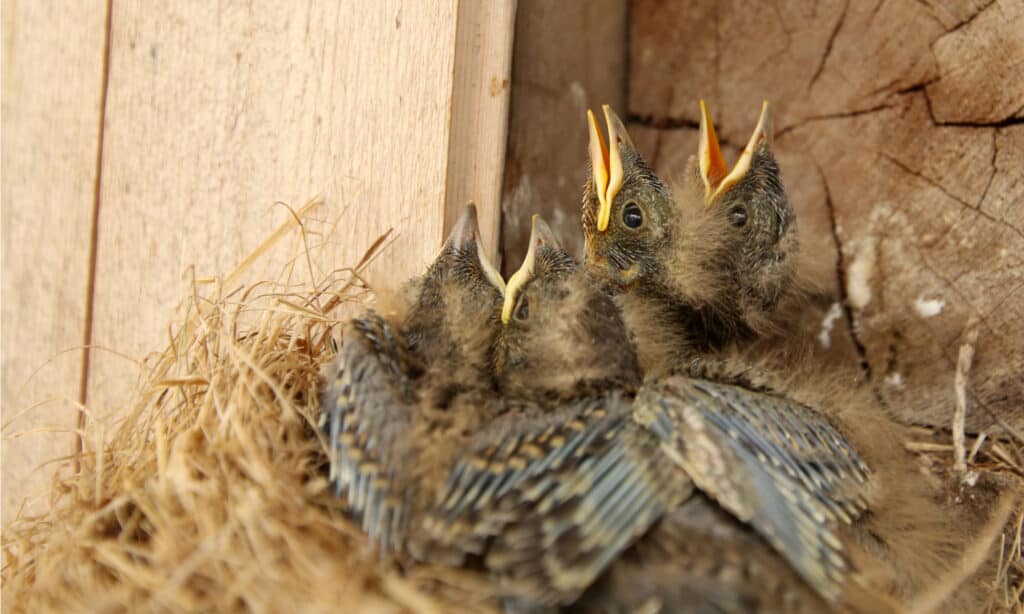
Eurasian jays care for their chicks until about 2 months after they have fledged
©Jojoo64/Shutterstock.com
Eurasian jays mate once a year between March and June. When they gather together in groups, these birds perform their courtship rituals in order to attract a mate. Males will tend to display more than females. He will chase after her in a complex flying display and also offer her food. After mating with each other, the female will lay a single clutch of four to five eggs in the nest. Both parents will take turns incubating the eggs.
It takes about 18 days later for the chicks to hatch. They are born almost completely naked and blind, dependent on their parents. Even after the chicks start to fledge at around 20 days, they will continue to remain with the parents for at least two months, when they truly begin to fend for themselves. It takes about two years to reach full sexual maturity. Due to disease and predators, the average lifespan is only a few years in the wild. The oldest recorded lifespan for this species was nearly 17 years.
Population
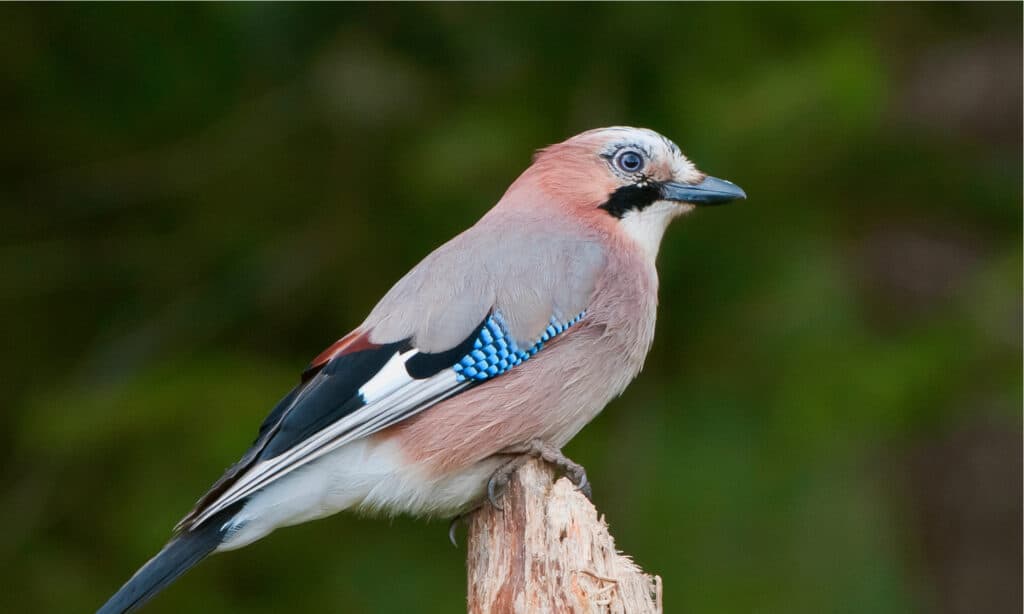
The Eurasian Jay is doing rather well population-wise with a population ranging between 30 – 65 million in the wild
©janveber/Shutterstock.com
The IUCN estimates that there are between 30 million and 65 million mature individuals in the wild. Numbers currently appear to be stable and widespread.
View all 117 animals that start with EEurasian Jay FAQs (Frequently Asked Questions)
Does the Eurasian jay migrate?
The Eurasian jay is not a migratory species (except perhaps in some parts of its range), but it may undertake a short migration only if the acorn crop fails for the year.
How many eggs does the Eurasian jay lay?
A single clutch normally consists of four or five eggs.
How fast does the Eurasian jay fly?
The flight speed has never been accurately measured, but it’s thought to be somewhere around 20 miles per hour.
What is the Eurasian jay’s wingspan?
It has a wingspan of around 2 feet long.
When do Eurasian Jays leave the nest?
The chicks start to leave the nest at a few weeks old, but it may take two months to become fully independent.
Where do Eurasian jays live?
The Eurasian jay lives in mixed forest and grassland habitats through much of Eurasia and parts of North Africa.
Are blue jays and Eurasian jays related?
Blue jays and Eurasian jays are both members of the Corvidae family (which they share with crows and ravens), but blue jays are part of a separate genus, Cyanocitta.
What does Eurasian jay eat?
They eat a wide variety of different plant materials and small animals, but their favorite food by far is acorns.
Thank you for reading! Have some feedback for us? Contact the AZ Animals editorial team.
Sources
- Animal Diversity Web / Accessed March 2, 2022
- IUCN Redlist / Accessed March 2, 2022


















